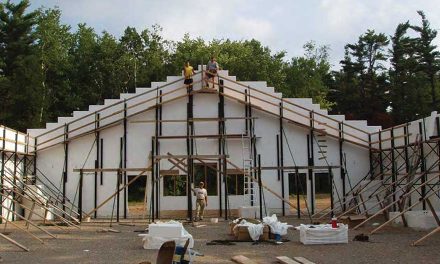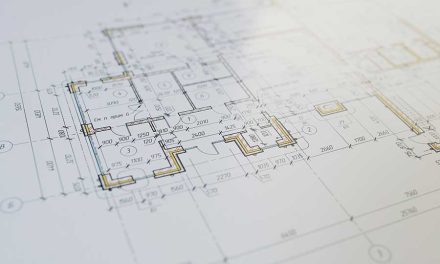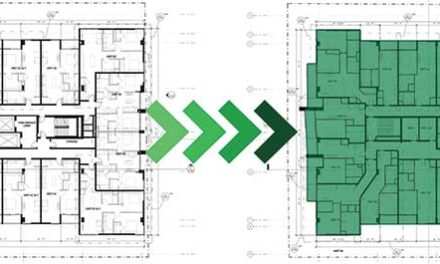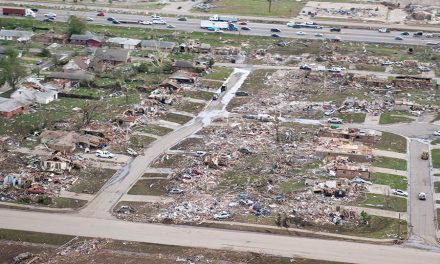By Brian Corder and Andy Lennox
The What
Imagine a wall with normal room temperature on one side and freezing arctic temperatures on the other. An ICF wall will take more than 300 hours to succumb to the cold, and even then, it still insulates at an R-27. Wait, what? The dense EPS foam combined with the strong concrete core work together to prevent any change in wall temperature.
What about a house on the beach built to current standards that takes a direct hit from a Category Four hurricane and survives unscathed? Or a home in the Florida Keys, newly built where the owner drives down to open the garage doors before the storm, only to return days after to close the doors and look at the resort next door in ruins while his home has only minor cosmetic damage.
Or even the subdivision in southern California that is completely burned to the ground from fast-moving wildfires, except for three homes built with ICFs.
But, we’re getting ahead of ourselves a bit; where did this come from?
Some of the most notable advances in technology come through decades of discovery and improvement. The greatest leaps happen when areas of old technology are suddenly combined in new ways and exciting new applications. Insulating Concrete Forms (ICFs) are a perfect example of this. The Romans used hydraulic cement to build buildings, bridges, ports, and aqueducts; many are still standing today. Insulating Concrete Forms are a technology born with ancient roots in Roman era concrete and the ingenuity of modern industrial revolution. Refined during the space race and introduced as a viable building product in the late 1980s and early 1990s, ICFs continue to evolve and deliver benefits in unexpected ways. ICFs are simply a form for concrete with integrated high-density insulation, integrated furring studs, a vapor barrier and more.
The Why
ICFs are strong since their supporting structure is steel-reinforced concrete. They create superior soundproofing and energy-efficiency due to their solid monolithic construction, airtight nature, and the sound absorbing properties of EPS foam. The materials that create EPS foam are a byproduct of the refining process that would otherwise go to waste or disposable products in a landfill. ICFs take that waste and turn it into a product that reduces energy costs and saves lives during disasters. Placing this foam in a building wall system where it is protected from decay and it continues to provide high-density insulation for generations to come is the best use of this material.
ICFs take this concept even further and integrate studs for walls just underneath the EPS foam. This stops thermal bridging from the inside to the outside. And since these studs are anchored deep in the concrete structure, they are the strongest attachment possible in a home or building.
Why else should I choose ICFs for my home? In studying ICF walls in a variety of climate zones, independent testing shows that the worse the conditions, the better ICFs perform. An ICF is a thermal insulation sandwich that protects the strong solid concrete core. But why protect the concrete? It turns out that just like sidewalks after a hot summer’s day radiate heat into the night, that concrete when protected from temperature swings and the elements wants to stay the same temperature and is very slow to change. Even if it does change slightly, it’s insulated both from the outside and the inside of the building making it even harder to lose precious heat or cooling inside.
In short, it’s never hot or cold long enough outside to move through the insulation, change the concrete, penetrate the insulation inside and change the temperature of the home.
What’s Next?
Building codes continue to evolve both in terms of energy efficiency requirements and disaster resilience. The truly marvelous characteristic about ICFs is that they meet the most stringent building requirements today and are poised to perform beyond tomorrow’s code needs too. The most impressive benefit of ICFs is that no matter what need has drawn you to consider ICFs, you gain all of the other benefits at no additional cost. And those benefits last for the lifetime of the home.
Get educated and decide for yourself that there’s a better way to build that will pay you back for generations.
Getting Started with ICFs Checklist
Educate Yourself (and others!)
- Visit https://ICF-MA.org
- The Insulating Concrete Form Manufacturers Association conveniently has links to all the ICFMA manufacturers. This is the fast track way to connect with ICF products and support services that are available.
Find A Local ICF Installer or Designer
- Simply contact an individual ICF brand or a local ICF dealer for referrals for an installer or a designer if you need plans or have questions.
- There are also a number of online directories you can use – google something like “ICF experienced installers” or “ICF experienced designers”.
Get Help Designing Your First ICF Building or Home
- There are a number of helpful articles online. Start by googling something like “ICF design tips”.
- Most ICF brands offer online or telephone technical support and design assistance for their particular brand and have relationships with architects or home designers.
Get Help Engineering Your ICF Walls
- ICF wall engineering standards are contained in the national building codes for Canada and the USA.
- As well, many ICF brands offer stamped prescriptive engineering tables and these are usually available on their website. Some ICF engineering apps are also available.
- Brands can also often refer you to engineers, or you can google “ICF experienced engineer”.
What’s it Going to Take?
- There are lots of resources to determine the amount of block needed, rough costs, and time-saving techniques.
- Robust manufacturer apps provide detailed estimates and precise product quantities.
- A simple Google search for “ICF Estimator” or a visit to the brand’s website is another great start.
Learn Where and How To Buy ICFs
- Many ICF brands are sold by local stocking dealers. Others are sold direct to contractors and others are sold online direct to consumers.
- To learn how each ICF is sold you should visit the individual brand’s website or contact them directly.
Get Training and Technical Support For Your ICF Installation
- Some ICF brands also offer installer training videos on their websites or YouTube Channels.
- Most ICF brands post their installation guidelines and procedures on their website. On-site training and technical assistance can also be available.
- Google “ICF installer training” to get a quick overview of available resources.
Andy Lennox is chair of the ICF Manufacturers Association and president of Logix Brands. Brian Corder is marketing chair for the ICFMA and president of BuildBlock Building Systems.













